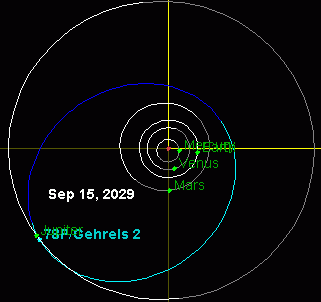

 | |
| Discovery | |
|---|---|
| Discovered by | Tom Gehrels |
| Discovery date | September 29, 1973 |
| Designations | |
| 1973 XI; 1981 XVII; 1989 XVII | |
| Orbital characteristics | |
| Epoch | March 6, 2006 |
| Aphelion | 5.462 AU |
| Perihelion | 2.009 AU |
| Semi-major axis | 3.735 AU |
| Eccentricity | 0.4622 |
| Orbital period | 7.22 yr |
| Inclination | 6.2530° |
| Last perihelion | April 2, 2019[1][2] January 12, 2012[3] October 27, 2004[1][4] |
| Next perihelion | 2026-06-25[5] |
78P/Gehrels, also known as Gehrels 2, is a Jupiter-family periodic comet in the Solar System with a current orbital period of 7.22 years.
It was discovered by Tom Gehrels at the Lunar and Planetary Laboratory, Arizona, USA on photographic plates exposed between 29 September and 5 October 1973 at the Palomar Observatory. It had a brightness of apparent magnitude of 15. Brian G. Marsden computed the parabolic and elliptical orbits which suggested an orbital period of 8.76 years, later revising the data to give a perihelion date of 30 November 1963 and orbital period of 7.93 years.[6]
The comet's predicted next appearance in 1981 was observed by W. and A. Cochran at the McDonald Observatory, Texas on 8 June 1981. It was observed again in 1989 and in 1997, when favourable conditions meant that brightness increased to magnitude 12.[6] It has subsequently been observed in 2004 when it reached magnitude 10, 2012, and 2018.[1]
Comet 78P/Gehrels' aphelion (furthest distance from the Sun) of 5.4AU[3] is in the zone of control of the gas giant Jupiter and the orbit of the comet is frequently perturbed by Jupiter.[7] On September 15, 2029, the comet will pass within 0.018 AU (2.7 million kilometers) of Jupiter[7] and be strongly perturbed. By the year 2200, the comet will have a centaur-like orbit with a perihelion (closest distance to the Sun) near Jupiter.[8] This outward migration from a perihelion of 2AU to a perihelion of ~5AU could cause the comet to go dormant.
| Year (epoch) | 2009[3] | 2030 | 2200[8] |
|---|---|---|---|
| Semi-major axis | 3.73 | 6.02 | 9.37 |
| Perihelion | 2.00 | 4.08 | 4.99 |
| Aphelion | 5.46 | 7.96 | 13.7 |

| Numbered comets | ||
|---|---|---|
| Previous 77P/Longmore |
78P/Gehrels | Next 79P/du Toit–Hartley |
|
2019 in space
| ||
|---|---|---|
2020 » | ||
| Space probe launches |
| |
| Impact events |
| |
| Selected NEOs |
| |
| Exoplanets |
| |
| Discoveries |
| |
| Comets |
| |
| Space exploration |
| |
| ||